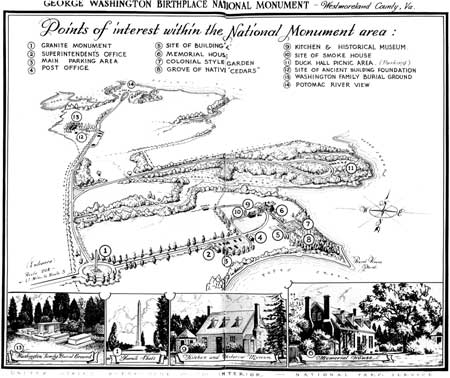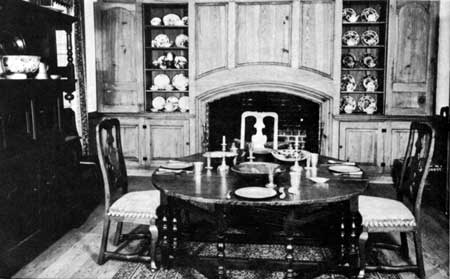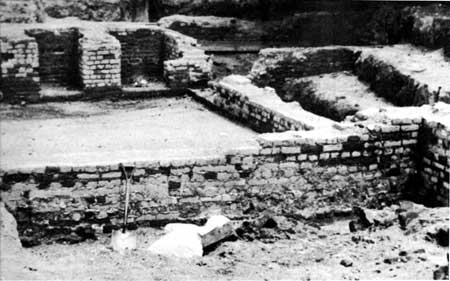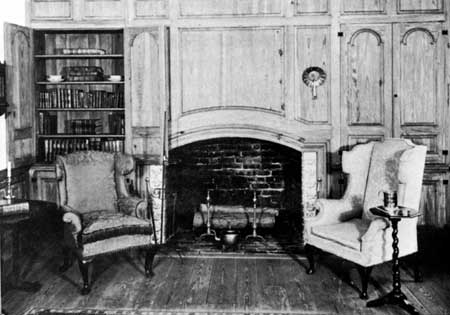|
GEORGE WASHINGTON BIRTHPLACE National Monument |
 |

(click on image for an enlargement in a new window)
Guide To The Area
The information which follows, supplements that contained in the narrative of this handbook. It has been arranged to enable you to make your own tour of the area. The numbers given correspond to the numbers on the map of the national monument (above).
1. GRANITE SHAFT. This shaft, of Vermont granite, weighs about 50 tons. It is nearly one-tenth the size of the Washington Monument in the Nation's capital, and of the same relative proportions. First erected in 1896 by the War Department (at or near the foundations of the home in which George Washington was born), it was moved to its present location near the entrance to the national monument in 1930.

Tilt-top table in the dining room. The only piece
of furniture in the memorial house believed to be from the home in which
Washington was born.

Dining room. Many of the items of tableware shown
are similar to types unearthed at Washington's
birthplace.
2. SUPERINTENDENT'S OFFICE. Visitors seeking information are always welcome here.
3. MAIN PARKING AREA.
4. POST OFFICE, WASHINGTON'S BIRTHPLACE, VA. Souvenirs, postcards, potted plants, and soft drinks may be purchased in the post office building.

Brick foundations of a part of Building "X", an early building
unearthed at Washington's birthplace.
5. SITE OF BUILDING "X." So-called because its history is unknown, the brick foundations of Building "X" were discovered in 1930. They were partially unearthed that year, and completely excavated in 1936. The boxwood plants outline only one room of the building, known as Unit "A." The brick foundations of Building "X" were the most extensive ones unearthed at Wakefield. Including the projecting wings, the foundations were almost 70 feet long. The center of the building was approximately 19 feet wide. One wing was 22 feet wide, the other 32 feet wide. The possibility that it, rather than the smaller foundation on the memorial mansion site about 60 feet away, was the exact spot where George Washington was born cannot be ignored and will perhaps always remain an intriguing question.

Master bedroom.

The children's room.
6. MEMORIAL HOUSE. This was built in 1930—31. The furnishings are of the 1700-50 period. One item, a tilt-top table, is the only existing piece of furniture said to have been in the original house at Wakefield, having been saved at the time of the fire in 1779. Much of the pottery, porcelain, glassware, tableware, and metalware in the house are similar in period and style to many of the artifacts which were unearthed near the birthsite during archeological excavations.
7. COLONIAL-STYLE GARDEN. South of the memorial house is a colonial-type garden enclosed by a handsplit picket fence. It is connected with the memorial house by a boxwood-lined brick walk. The English boxwood is well over a century old, and was transplanted from the home, 8 miles away, of Sarah Tayloe Washington (a daughter of the last occupant and owner of the home in which George Washington was born.) It is believed to have grown from cuttings originally taken from Wakefield. In this fragrant, old-fashioned garden, will be found many plants that were common to Virginia gardens during the period of George Washington's youth. Here are sweet-scented herbs such as sage, thyme, hyssop, wormwood, marjoram, rue, tansy, penny-royal, basil, hoarhound, snakeroot, true lavender, caraway, and others used for cooking and medicinal purposes. Among the colorful flowers are old roses, hollyhocks, lilies, bleedinghearts, forget-me-nots, love-in-a-mist, narcissi, iris, and heliotrope.
8. GROVE OF EASTERN REDCEDARS. South of the colonial garden is a magnificent grove of eastern redcedars, Juniperus virginiana. The grove covers Burnt House Point, which juts out into Popes Creek.

|
|
Last Modified: Mon, Jan 20 2003 10:00:00 pm PDT |


